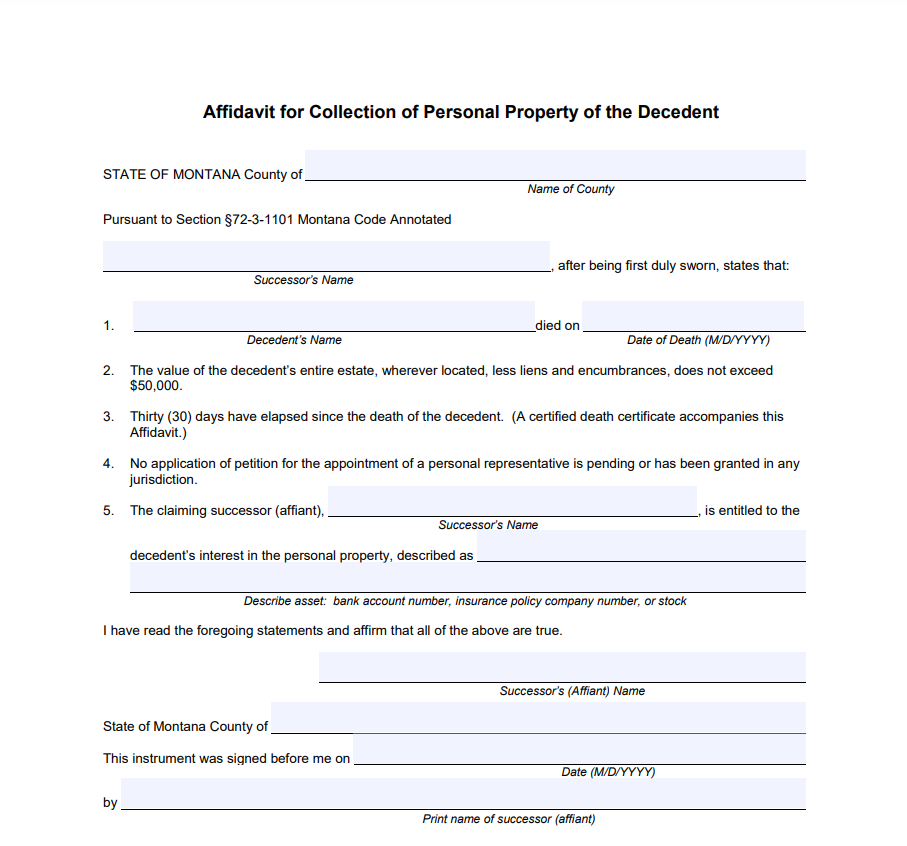Non Probate Affidavit Montana – Non Probate Affidavits in Montana are necessary paperwork when pursuing an estate. The assets of the estate must be fully described in these documents. The worth of the assets have to be mentioned as well. Both the beneficiary and the estate’s executor must sign the paperwork.
A declaration of heirship
An affidavit of heirship allows you to claim your deceased loved one’s part of the estate and skip probate court in Montana if you have a small inheritance and they died without making a will. You can claim personal property and skip the time- and money-consuming probate procedure with the use of a small estate affidavit.
In the state of Montana, an affidavit of heirs may be submitted to the county’s office of deed records. You can release any monies stored in an account as well as claim a share of any real estate and other personal property using this form.
This kind of document is typically necessary if you want to inherit property from a deceased person. Before completing the form, you must be certain that you have the legal right to receive the property. In the event that the property owner won’t part with it, you must hire a lawyer and launch a lawsuit.
administration in brief
In Montana, a shorter legal procedure than a standard probate is available for minor estates: a summary administration of non-probate affadavit. If the estate in Montana has less than $50,000 in homestead property, $10,000 in exempt property, or $18,000 in family allowance, you may apply this procedure. The Universal Probate Code, which permits casual and unsupervised probate, has been enacted by 18 states, including Montana. However, in most cases, the length of the legal process is mostly influenced by the size of the estate.
A simple administration of non-probate affadavit is a successful method for settling small estates. Even if the deceased passed away without leaving a will, this procedure can be applied. You must have at least one willing heir who is willing to sign the affidavit if you want to be eligible for the streamlined administration of non-probate process. A 45-day notice period following the decedent’s death is also required in order to use the streamlined administration procedure.
TOD acts
The Montana Uniform Real Property Transfer on Death Act explicitly addresses the state’s real estate transfer requirements. Additionally, it’s crucial to refrain from utilizing generic TOD deed forms since they may result in invalid deeds and title insurance issues. You should work with a lawyer to make sure the transfer goes well. For instance, Austin, Texas lawyer Jeramie Fortenberry has created thousands of deeds for clients.
Basic details like the legal description of the property and the beneficiary’s name and address must be included when preparing a TOD deed. If you intend to transfer the property, a TOD deed must also be notarized. Either all of the owners or just one of them must sign the document.
A TOD deed may also name a charity or company as a beneficiary in addition to a family member or acquaintance. A TOD deed may also name many beneficiaries who will divide the property equally. In some cases, a contingent beneficiary is also named, who will become the owner in the event that the primary beneficiary passes away.
substitutes for formal probate
Probate is the name given to the legal procedure used to disperse a deceased person’s property. It can be a long and tiresome procedure. If a person passed away in Montana and left behind a Will or assets without a named beneficiary, they must go through this procedure. In Montana, there are several different types of probate, and the processing times for each one can differ.
For estates with significant assets, probate is required. When the deceased person held real estate, it might also be necessary. In some circumstances, the deceased person passed away without leaving a will, or intestate. When a person goes away without a will, their property transfers to the next closest surviving relative, who is typically their spouse or grown kid. The assets held in a living trust, life insurance policies, retirement funds, bank accounts with pay-on-death features, and real estate are examples of exceptions to this rule.
Fortunately, there are approaches to completely bypass official probate. The distribution of a loved one’s assets after death is made simpler for survivors in Montana thanks to a number of probate process shortcuts. Many people decide to stay away from probate court proceedings since they are expensive and time-consuming in order to save their families the hassle. There are several alternatives to formal probate in each state of Montana, but you can learn more about them by visiting the state website.
Download Non Probate Affidavit Montana Form 2022
